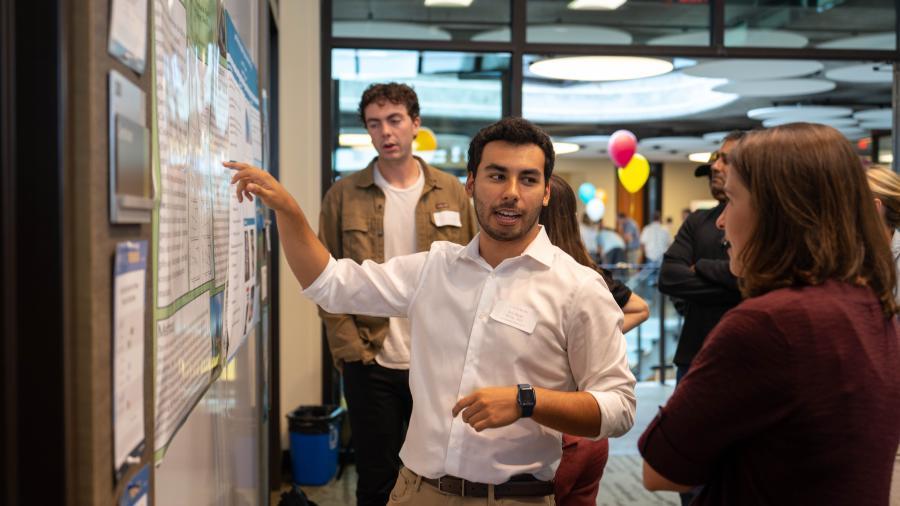Westmont Magazine Record Number of Students Research

This past summer, faculty busily conducted research with a record 39 students from nine departments, including all the natural and behavioral science departments as well as the art museum, communication studies and political science. The students showed off more than 25 research projects to the Westmont community, including dozens of prospective STEM students, at the annual Celebration of Summer Research in the Winter Hall Atrium.
Alexander Rurik ’23 and Eric Reyes ’24 worked with Amanda Sparkman, professor of biology, on Santa Cruz and Santa Rosa Islands for their research, “Short Legs and Island ‘Chunky-ism’: An Investigation of Morphology and Physiology of Channel Island Lizards.” They found that while the Western fence lizard differed little between island and mainland, island side-blotched lizards were surprisingly 14 percent heavier than the mainland population when adjusting for snout-vent length. “Our data didn’t point to dwarfism in these species, unlike the other three dwarf reptiles we’re studying on the islands,” Reyes says. “We don’t have a great hypothesis for the ‘chunkiness’ in the side-blotched lizards, but personally I think it’s because they have less competition for food,” Rurik says.
Ella Jennings ’23 spent the summer studying the ways more than 150 Alzheimer’s patients performed cognitive puzzles involving figure copying. “The Eyes Are the Window to the Brain: The Role of Visuospatial Abilities in Alzheimer’s Disease” examined the ways that patients struggle to understand visual information and perform cognitive functions. The research, conducted with Steven A. Rogers, professor of psychology, showed the largest decline in figure-copying ability appears to occur predominantly through visuospatial rather than cognitive channels. “Listening to each one of these patients and understanding how their lives have been affected, I’m inspired to do what I can to help them,” Jennings says.
Daniel Rubin ’23, a surfer and skateboarder, seeks to enhance the market of wrist-wearable products to include advanced maneuver detection of snaps, cutbacks and take-off analytics. “Surf-session analysis is becoming a popular market for commercial wearable devices. However, these devices only offer analytics on ridden waves, speed and GPS tracking,” Rubin says. He designed and 3D-printed the housing for a wrist-mounted device to encase the sensing electronics. He performed surfing maneuvers in a 3D-motion-capture lab and snap maneuvers on his skateboard to obtain acceleration, gyroscope and magnetometer data.
Many of these research projects extend into the school year, with students even co-authoring scholarly papers with their professors. More than 40 researchers presented their findings at the Spring Research Symposium on April 20. Chloe Howard ’22, now enrolled in Westmont’s Accelerated Bachelor of Science in Nursing (ABSN) program, presented “Defining Westmont Christian College’s Dating Rules as an Enthusiastic and Indecisive Female,” conducted with supervisor Felicia Song, professor of sociology. Madison Chong ’22 and supervisor Gewnhi Park, associate professor of psychology, examined “Caffeine Stress and Mood.” Abigail Bradshaw ’23 offered “Listening to Laughter: The Art of Listening to Augmentative and Alternative Communication,” a project with supervisor Greg Spencer, professor of communication studies.